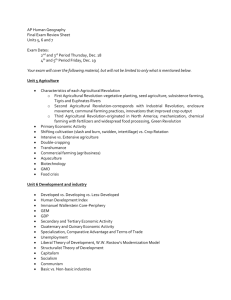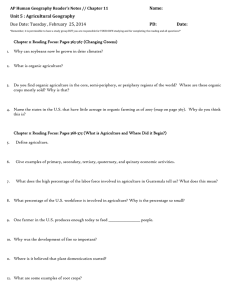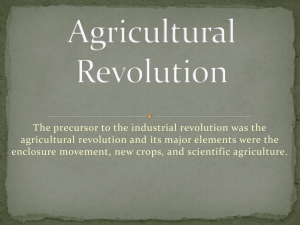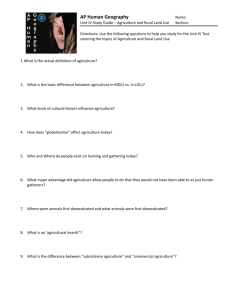NAME: _________________________________ July 11, 2016 A.P. ENVIRONMENTAL SCIENCE TAKE HOME TEST
advertisement
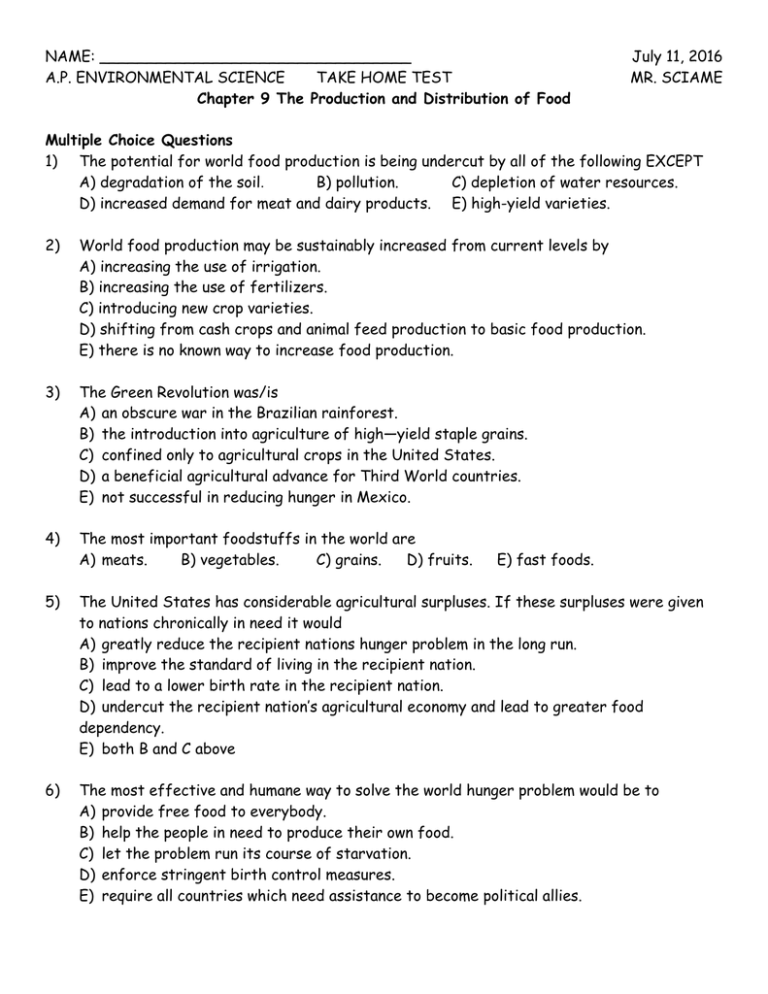
NAME: _________________________________ A.P. ENVIRONMENTAL SCIENCE TAKE HOME TEST Chapter 9 The Production and Distribution of Food July 11, 2016 MR. SCIAME Multiple Choice Questions 1) The potential for world food production is being undercut by all of the following EXCEPT A) degradation of the soil. B) pollution. C) depletion of water resources. D) increased demand for meat and dairy products. E) high-yield varieties. 2) World food production may be sustainably increased from current levels by A) increasing the use of irrigation. B) increasing the use of fertilizers. C) introducing new crop varieties. D) shifting from cash crops and animal feed production to basic food production. E) there is no known way to increase food production. 3) The Green Revolution was/is A) an obscure war in the Brazilian rainforest. B) the introduction into agriculture of high—yield staple grains. C) confined only to agricultural crops in the United States. D) a beneficial agricultural advance for Third World countries. E) not successful in reducing hunger in Mexico. 4) The most important foodstuffs in the world are A) meats. B) vegetables. C) grains. D) fruits. E) fast foods. 5) The United States has considerable agricultural surpluses. If these surpluses were given to nations chronically in need it would A) greatly reduce the recipient nations hunger problem in the long run. B) improve the standard of living in the recipient nation. C) lead to a lower birth rate in the recipient nation. D) undercut the recipient nation’s agricultural economy and lead to greater food dependency. E) both B and C above 6) The most effective and humane way to solve the world hunger problem would be to A) provide free food to everybody. B) help the people in need to produce their own food. C) let the problem run its course of starvation. D) enforce stringent birth control measures. E) require all countries which need assistance to become political allies. 7) In less developed countries with a hunger problem, it is most critical to focus development efforts on A) increasing the gross national product. B) providing modern industrial manufacturing plants. C) enabling local farmers to produce more food more profitably. D) introducing industrial farming techniques. E) training highly skilled workers. 8) Which is NOT a characteristic of high—yield varieties? A) need irrigation B) need pesticides C) need fertilizers D) ideal for subsistence farming E) yields beginning to plateau 9) Which is NOT a characteristic of subsistence farming? A) small plots B) low technology C) dependable cash income D) labor intensive E) most common approach in rural populations 10) The effect of climate on world food production A) is variable and therefore unpredictable on the short term. B) is expected to increase future yields. C) consistently favors production in temperate regions. D) has been abnormally variable but should become more consistent. E) none of the above 11) Raising livestock may be worsening the greenhouse effect with A) methane production of cows. B) anaerobic decay of manure. C) volatile products of metabolism of animal fats. D) A and B E) A and C 12) Giving food to developing nations A) is a disincentive for poor countries to improve their own productivity B) does nothing to save lives during famines. C) creates new lucrative markets for developed countries D) all of the above E) none of the above 13) Sustainable agricultural systems A) are impossible to create. B) must be patterned after natural ecosystems. C) rely on inputs of pesticides and fertilizers. D) result from modern agricultural practices. E) none of the above 14) Before the Industrial Revolution, agricultural crops were maintained through A) crop rotation. B) planting a variety of crops. C) returning animal waste to the soil. D) all of the above E) none of the above 15) The Industrial Revolution introduced which of the following into American agriculture? A) machinery B) fertilizers C) pesticides D) irrigation E) all of the above 16) Chemical pesticides may not be effective for long—term pest control because A) they tend to break down easily in the environment. B) some pests are naturally resistant to the pesticide. C) they are too expensive to use. D) they don’t increase crop yields. E) they are effective for long—term control. 17) Overuse of fertilizers can lead to A) minimal gain in crop production. B) plants which are vulnerable to pests. C) water pollution. D) none of the above E) all of the above 18) Norman Borlaus received the Nobel Peace Prize in 1970 for A) development of a dwarf hybrid wheat plant, which produced a high yield of wheat in warm weather. B) the discovery of fertilizers. C) his discovery of organic pesticides. D) genetically engineered, pest—resistant plants. E) his discovery that crop rotation can decrease pests in a given field. 19) In the United States, _________ of grain crops are grown to feed domestic animals. A) 20 percent B) 50 percent C) 70 percent D) 90 percent E) 95 percent 20) Industrial-style animal farming is considered to be sustainable because A) animals graze on land which is not used for crops. B) animals may graze on public land which is leased from the government for very little money. C) manure produced from these animals is a valuable resource. D) the carrying capacity of the land remains the same. E) industrial-style animal farming is not sustainable. 21) Animal waste(s) produced from Industrial-style farming A) is used as a valuable resource. B) contributes greatly to pollution in rivers. C) may kill fish in polluted water. D) are adequately treated in wastewater treatment plants. E) B and C 22) Which of the following are NOT TRUE about the use of biotechnology in food production? A) Bacteria has been developed which produce a hormone that induces greater milk production. B) Transgenic cotton plants contain genes from bacteria which give them resistance to pests. C) Tomatoes are grown which stay fresh longer. D) All farmers will be able to use advances in biotechnology. E) All of the above are true. 23) The lack of essential nutrients such as amino acids, vitamins and mineral is referred to as A) chronic hunger. B) malnutrition. C) undernutrition. D) starvation. E) overnutrition. 24) The lack of basic food energy (calories) is referred to as A) chronic hunger. B) malnutrition. C) undernutrition. D) starvation. E) overnutrition. 25) Overnutrition and obesity can lead to A) heart disease. B) increased blood pressure. D) diabetes. E) all of the above C) cancer. True/False Questions 26) The Industrial Revolution has contributed to the Agricultural Revolution by reducing labor through mechanization, and increased production through fertilization and genetic engineering. 27) Prior to 1960, increased production was achieved only through conversion of other land to cropland. 28) Increased use of pesticides has not significantly reduced or controlled the pest population. 29) Major crop damage may be more severe as a result of genetically identical crops, coupled with pesticide resistant pests. 30) Attempting to improve the nutritional quality of life for countries with serious food problems launched the Green Revolution. 31) Subsistence farming relies heavily on large tracts of land where rural households grow enough food for their own consumption. 32) Some food shortages are a direct result of overgrazing by domesticated herbivores. 33) The United States and Canada combined are the leading importers of grain crops in the world. 34) Food aid to needy people is often based more on political and economic alliances than on true need. 35) The root cause of hunger is poverty. 36) According to Garrett Hardin, the First Commandment of Ecology should be “Thou shalt not transgress the carrying capacity.” 37) On a global basis, there is no shortage of food. 38) The rising debt of developing nations has tended to encourage farmers to raise cash crops rather than meet their own basic food needs. 39) Not a single country has improved its food situation in the last two decades. 40) One-fourth of the world’s croplands are used to feed domestic animals. 41) Cattle grazing contributes to the destruction of the tropical rain forests. 42) Methane, a greenhouse gas, is regularly released into the air by cows. 43) World grain production from year to year is constant. 44) Feeding grain to livestock and eating the livestock or their products is an efficient use of solar energy. 45) The “Neolithic Revolution” that saw the beginning of agriculture and animal husbandry originated about 10,000 years ago. Short Answer Questions 46) The ________ was the introduction into agriculture of high yield, staple grains. 47) _________________ are rural populations that farm small plots of land for food and livestock to maintain their households. 48) _________ are the world’s most important source of nutrition. 49) The general term for referring to a basic lack of food required for energy and nutrition is _________________ 50) The lack of essential nutrients is called _________ 51) A _________ is referred to as a chronic, severe shortage of food accompanied by an increase in the death rate. 52) __________________ utilizes plant and animal wastes and green manure instead of chemical fertilizer applications. 53) Subsistence farmers who cut down forests, burn the remains to release nutrients, and then plant food crops are practicing __________________agriculture. 54) Methane produced by cows and by anaerobic decay of manure is likely to worsen the _______________ 55) Crops and animals which have genes transplanted into their genome from another species are called _______ 56) The introduction into agriculture of high yield staple grains is known as the ________ 57) Prior to the _________________ agriculture relied more heavily on hard labor than it did on machines. 58) Land capable of supporting agriculture is ________ land. 59) ________ is the process of artificially providing water to crops. 60) The chronic shortage of food for humans in a given area is called _________ Matching Questions - Match the correct word(s) with the phrase. Not all answers may be used. A. B. C. D. E. malnutrition biodiversity sustainable agriculture Green Revolution food aid F. G. H. I. J. food security famine absolute poverty subsistence farming organic farming 61) Expansion of agricultural output as the result of technology 62) Traditional agricultural methods that are labor intensive 63) Ability to meet food needs at the family level 64) Lack of essential nutrients K. L. M. N. O. slash and burn high—yield varieties pastoralist saltwater intrusion drought 65) Inability to meet basic needs of food and shelter 66) Severe, chronic food shortages and consequent increases in death rate 67) Ability to meet food needs over long periods of time 68) Addition of crop and animal residues to soil 69) Aggravates poverty and hunger 70) Indicating the number of species in a given region 71) Plants with high productivity and environmental demands 72) A potentially sustainable approach to subsistence farming in tropical rain forests 73) One who makes a living by raising livestock. 74) The contamination of freshwater aquifers by salt water 75) Unusual periods of lower than average precipitation Essay Question 76) List the four principles of ecosystem sustainability and tell how they relate to the problems of hunger and food acquisition.

